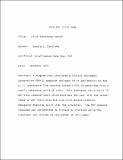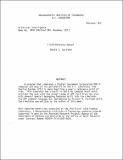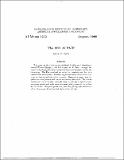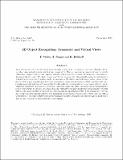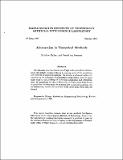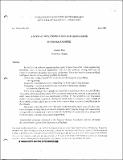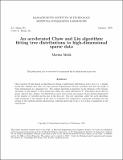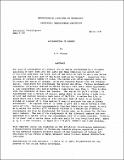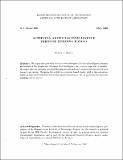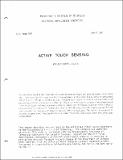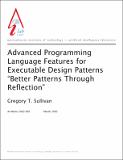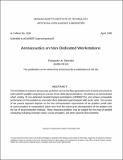Browsing AI Memos (1959 - 2004) by Title
Now showing items 1-20 of 1217
-
11SIM Reference Manual
(1971-12-01)A program that simulates a Digital Equipment Corporation PDP-11 computer and many of its peripherals on the AI Laboratory Time Sharing System (ITS) is described from a user's reference point of view. This simulator has ... -
11SIM Reference Manual
(1972-02-01)A program that simulates a Digital Equipment Corporation PDP-11 computer and many of its peripherals on the AI Laboratory Time Sharing System (ITS) is described from a user's reference point of view. This simulator has ... -
1968-1969 Progress Report
(1970-01-01)This report mainly summarizes the Project MAC A.I. Group work between July 1968 and June 1969 but covers some work up to February 1970. The work on computer vision is described in detail. This summary should be read ... -
The 1990 AI Fair
(1990-08-01)This year, as the finale to the Artificial Intelligence Laboratory's annual Winter Olympics, the Lab staged an AI Fair ??night devoted to displaying the wide variety of talents and interests within the laboratory. The ... -
3D Object Recognition: Symmetry and Virtual Views
(1992-12-01)Many 3D objects in the world around us are strongly constrained. For instance, not only cultural artifacts but also many natural objects are bilaterally symmetric. Thoretical arguments suggest and psychophysical ... -
3D Pose from Three Corresponding Points Under Weak-Perspective Projection
(1992-07-01)Model-based object recognition commonly involves using a minimal set of matched model and image points to compute the pose of the model in image coordinates. Furthermore, recognition systems often rely on the ... -
Abstraction in Numerical Methods
(1987-10-01)We illustrate how the liberal use of high-order procedural abstractions and infinite streams helps us to express some of the vocabulary and methods of numerical analysis. We develop a software toolbox encapsulating the ... -
Abstraction, Inspection and Debugging in Programming
(1981-06-01)We believe that software engineering has much to learn from other mature engineering disciplines, such as electrical engineering, and that the problem solving behaviors of engineers in different disciplines have many ... -
An Accelerated Chow and Liu Algorithm: Fitting Tree Distributions to High Dimensional Sparse Data
(1999-01-01)Chow and Liu introduced an algorithm for fitting a multivariate distribution with a tree (i.e. a density model that assumes that there are only pairwise dependencies between variables) and that the graph of these dependencies ... -
Acceleration of Series
(1974-03-01)The rate of convergence of infinite series can be accelerated b y a suitable splitting of each term into two parts and then combining the second part of the n-th term with the first part of the (n+1) -th term t get a new ... -
Achieving Artificial Intelligence through Building Robots
(1986-05-01)We argue that generally accepted methodologies of Artificial Intelligence research are limited in the proportion of human level intelligence they can be expected to emulate. We argue that the currently accepted ... -
Active Learning with Statistical Models
(1995-03-21)For many types of learners one can compute the statistically 'optimal' way to select data. We review how these techniques have been used with feedforward neural networks. We then show how the same principles may be ... -
Active Touch Sensing
(1981-04-01)The mechanical hand of the future will roll a screw between its fingers and sense, by touch, which end is which. This paper describes a step toward such a manipulator ?? robot finger that is used to recognize small ... -
Activity Zones for Context-Aware Computing
(2003-06-10)Location is a primary cue in many context-aware computing systems, and is often represented as a global coordinate, room number, or Euclidean distance various landmarks. A user?s concept of location, however, is often ... -
Actors and Continuous Functionals
(1977-07-01)This paper presents precise versions of some "laws" that must be satisfied by computations involving communicating parallel processes. The laws take the form of stating plausible restrictions on the histories of ... -
Additions to LAP
(1967-07-01)In addition to the description on page 13 of AI Memo 116A LAP has the following features: Current Assembly Location Reference, Assembly Time Arithmetic, Constants, Multiple Entry Routines, and Defined Machine Operations ... -
Additions to Vision Library
(1966-08-01)Modified LAP: Additions have been made to LAP as described in the PDP-6 write-up. -
Advanced Programming Language Features for Executable Design Patterns "Better Patterns Through Reflection
(2002-03-22)The Design Patterns book [GOF95] presents 24 time-tested patterns that consistently appear in well-designed software systems. Each pattern is presented with a description of the design problem the pattern addresses, as ... -
Aeroacoustics on Non-Dedicated Workstations
(1995-04-01)The simulation of subsonic aeroacoustic problems such as the flow-generated sound of wind instruments is well suited for parallel computing on a cluster of non-dedicated workstations. Simulations are demonstrated which ... -
Affine Matching with Bounded Sensor Error: A Study of Geometric Hashing and Alignment
(1991-08-01)Affine transformations are often used in recognition systems, to approximate the effects of perspective projection. The underlying mathematics is for exact feature data, with no positional uncertainty. In practice, ...
